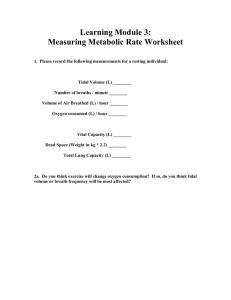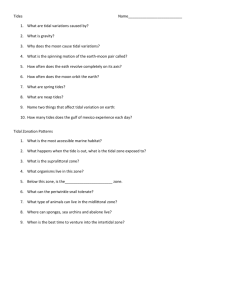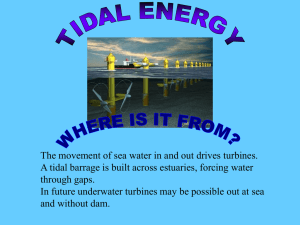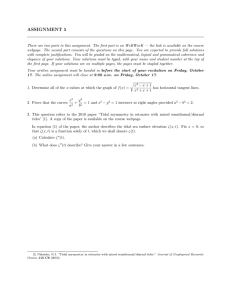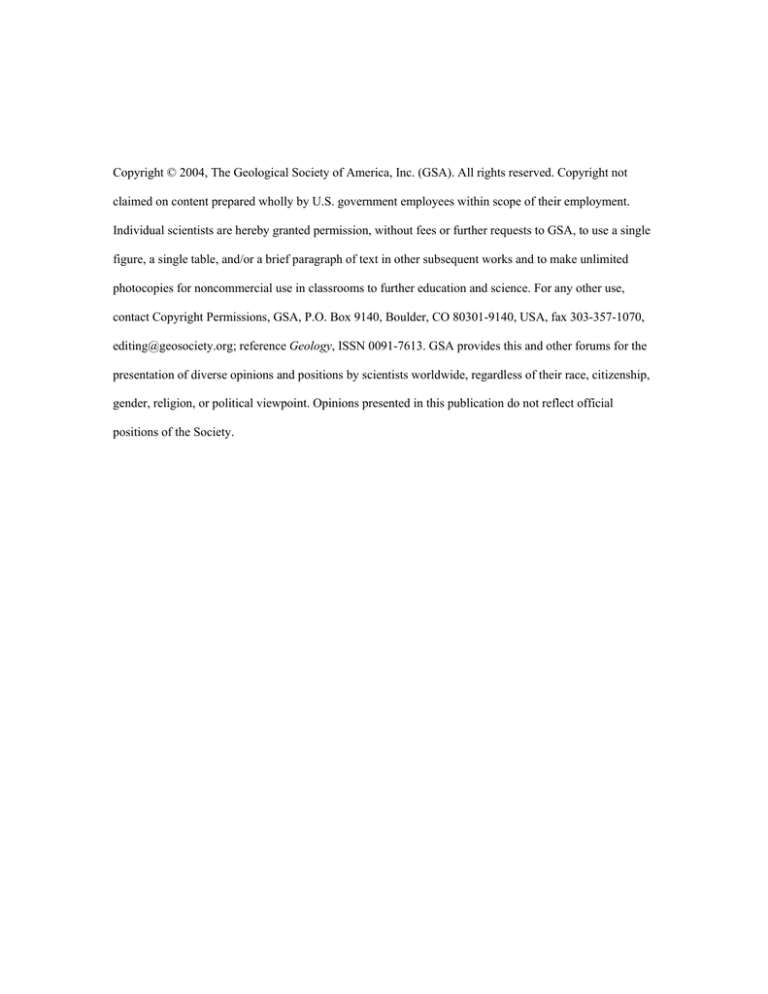
Copyright © 2004, The Geological Society of America, Inc. (GSA). All rights reserved. Copyright not
claimed on content prepared wholly by U.S. government employees within scope of their employment.
Individual scientists are hereby granted permission, without fees or further requests to GSA, to use a single
figure, a single table, and/or a brief paragraph of text in other subsequent works and to make unlimited
photocopies for noncommercial use in classrooms to further education and science. For any other use,
contact Copyright Permissions, GSA, P.O. Box 9140, Boulder, CO 80301-9140, USA, fax 303-357-1070,
editing@geosociety.org; reference Geology, ISSN 0091-7613. GSA provides this and other forums for the
presentation of diverse opinions and positions by scientists worldwide, regardless of their race, citizenship,
gender, religion, or political viewpoint. Opinions presented in this publication do not reflect official
positions of the Society.
Implications of lunar orbital periodicity from the Chaibasa tidal
rhythmite (India) of late Paleoproterozoic age
Rajat Mazumder*
Department of Geology, Asutosh College, Kolkata 700 026, India
ABSTRACT
Harmonic analysis of the sandstone foreset-laminae thickness series from the Chaibasa
tidal rhythmite, India, clearly shows that a normal semidiurnal tidal system with synodic
month of ;32 lunar days was in effect during the late Paleoproterozoic (2100–1600 Ma).
The minimum number of solar days in a lunar sidereal month was ;31. Published quantitative tidal-rhythmite data of others in combination with data derived from the Chaibasa
tidal rhythmite indicate long-term stability of the lunar orbit and progressive increase in
the Earth-Moon distance during the Proterozoic.
Keywords: tidal rhythmite, tidal cycles, lunar orbital periodicity, Earth-Moon system, Paleoproterozoic, Chaibasa Formation.
INTRODUCTION
Tidal rhythmites are vertically and/or laterally stacked thin beds or laminae, usually of
sandstone, siltstone, and mudstone, that exhibit rhythmic thickness variations as a consequence of strong lunar-solar tides (Williams,
1989; Kvale et al., 1999). Analysis of tidal
rhythmites coupled with an understanding of
tidal theory provides valuable information on
paleo–lunar orbital dynamics and the ancient
Earth-Moon system (Williams, 1989, 2000;
Archer et al., 1991; Sonett et al., 1996; Kvale
et al., 1999). Tidal periods have been documented in rocks as old as 3200 Ma (Eriksson
and Simpson, 2000). As Williams (2000)
pointed out, careful study of Precambrian tidal
rhythmites promises to illuminate the evolving
dynamics of the early Earth-Moon system. Although high-quality tidal-rhythmite data are
available from the Neoproterozoic (Williams,
1989, 2000; Chan et al., 1994; Sonett et al.,
1996; Archer, 1996), similar data are unavailable from the Mesoproterozoic and rare from
the Paleoproterozoic (Williams, 2000). Herein
I report lunar orbital periodicity from the
Chaibasa Formation (India) of late Paleoproterozoic age, along with the implications for
the evolving Precambrian Earth-Moon system.
GEOLOGIC SETTING
The 6–8-km-thick, entirely siliciclastic
Chaibasa Formation (Fig. 1) constitutes the
lower part of the two-tiered Singhbhum
Group, comprising rocks metamorphosed to
greenschist (locally amphibolite) facies (Naha,
1965; Saha, 1994). Lithologically it is char*Present address: Geological Institute, EIS, Yokohama National University, 79-7, Tokiwadai, Hodogaya ku, Yokohama 240-8501, Japan; e-mail:
mrajat2003@yahoo.com.
charyya, 1970). The Chaibasa Formation is
thus of late Paleoproterozoic age (cf. Mazumder, 2003). Lack of datable rock is the major
impediment to determining the precise age of
the Chaibasa Formation. Although the Chaibasa sandstones formed in a subtidal setting,
the shales formed in a distal offshore setting
and represent marine flooding surfaces (Bose
et al., 1997; Mazumder, 2002). The Chaibasa
succession is generally transgressive with intermittent punctuations caused by short-term
lowstands during which sandstones were emplaced (Mazumder et al., 2000; Mazumder,
2002; cf. Cattaneo and Steel, 2003).
Figure 1. Geologic map of study area. Chaibasa and Dhalbhum Formations together
constitute Singhbhum Group (simplified after Saha, 1994).
acterized by the interbedding of sandstones
and shales in different scales. The Chaibasa
Formation conformably overlies the 2100 Ma
Dhanjori Formation (Roy et al., 2002a) and is
unconformably overlain by the Dhalbhum
Formation (cf. Mazumder, 2003). The 1600
Ma (Roy et al., 2002b) Dalma lava conformably overlies the Dhalbhum Formation of the
Singhbhum Group (Bhattacharya and Bhatta-
METHOD
Basic Data
The focus of this paper is a cross-bedded
sandstone (Figs. 2A, 2B) best exposed in and
around Ghatshila (Fig. 1). The sandstones are
generally well sorted and internally characterized by unidirectional cross-strata (set thickness to 65 cm). The thick-thin laminae alternations are characteristic (Figs. 2B, 3A, and
4A), as is a double mud drape (Fig. 2B). In
places, the cross-bed sets exhibit cyclic intraset variation in stratification style, from
concave-up to planar to sigmoidal geometry
(Fig. 2A); the sets are characterized by sandstone foresets separated by mudstone drapes
(Fig. 2B). The abundance and thickness of
mudstone drapes vary across the sets, showing
an inverse relationship to the foreset thickness
in the sandstone: drapes are thinner and relatively rare in intervals of thick foresets and
abundant and thicker in intervals of thin foresets (cf. Tape et al., 2003). Laminae thickness is measured perpendicular to the dip of
the foresets along a horizontal line between
the upper and lower bounding surfaces. Cy-
q 2004 Geological Society of America. For permission to copy, contact Copyright Permissions, GSA, or editing@geosociety.org.
Geology; October 2004; v. 32; no. 10; p. 841–844; doi: 10.1130/G20424.1; 4 figures.
841
Figure 2. A: Cross-stratified Chaibasa sandstone showing variation in cyclic intraset crossstratification style, from concave-up to planar to sigmoidal geometry (length of each scale
is 16 cm). B: Chaibasa sandstone showing characteristic thick-thin laminae alternations and
double mud drape (pen length is 12 cm).
clicities are revealed in plots of two successive
foreset-thickness data sets measured from different stratigraphic levels from exposures 1
km southeast of Ghatshila (Figs. 1, 3A, and
4A). Random meteorological events like
storms may impart thick-thin alternations in
environments that lack semidiurnal tidal influence. Alternatively, semidiurnal thick-thin
laminae alternations may be disturbed by such
meteorological events (cf. de Boer et al.,
1989). A statistical test of the basic data has
therefore been made, following the methodology of de Boer et al. (1989), that reveals a
significant semidiurnal signal (Figs. 3A, 3B,
and 4A). The number of foreset laminae, constituting neap-spring cycles, varies from 27 to
30.
Figure 3. A: Rhythmic thickness variations
in successive foresets within crossstratified Chaibasa sandstone. B: Bar chart
showing absolute value of difference between successive laminae thicknesses (following methodology of de Boer et al., 1989)
presented in A. Semidiurnal signal is well reflected in both A and B. C: Fast Fourier
transform power spectral-density plots (unsmoothed) obtained from data set presented
in A. Note consistent spectral periods of ~32
and 2 events, respectively. Spectral period
of 190 events possibly indicates some longperiod tidal and/or nontidal variation. See
text for explanation.
842
Harmonic Analysis
Harmonic analysis following the methodology of Archer et al. (1991) and using a Fast
Fourier transform (FFT) program (Horne and
Baliunas 1986; Press et al., 1989) was performed on both data sets. The program tests
for cyclicities and is capable of separating cycles having closely spaced periodicities. The
output is expressed as an event/cycle in a frequency vs. power spectral-density plot (Figs.
3C and 4B).
INTERPRETATION
Power spectral-density plots show spectral
periods of 32 events that represent neap-spring
cycles, analogous to those derived from the
analysis of modern tides as well as from the
ancient record (Figs. 3C and 4B) (Archer et
al., 1991; Kvale et al., 1995; Williams, 2000).
Both the power spectra exhibit a spectral period of ;2. This result, coupled with the occurrence of alternating, millimeter-scale,
thick-thin laminae (Figs. 2C, 3A, and 4A),
corroborates a dominantly semidiurnal tide
GEOLOGY, October 2004
Figure 4. A: Bar chart showing thickness
variation of successive foresets within Chaibasa sandstone (thickness data collected
from subfacies D described in Bose et al.,
1997). B: Fast Fourier transform power
spectral-density plots (unsmoothed) obtained from data set presented in A. Note
consistent spectral periods of ~32 and 2
events, respectively. See text for explanation.
during the Chaibasa sedimentation (cf. de
Boer et al., 1989). Spectral peaks between 3–
5 (Figs. 3C and 4B) and ;13 were likely generated by some random variations (storms?).
The spectral peak at 23 might represent an abbreviated anomalistic period (cf. Archer, 1996;
Kvale et al., 1999). The spectral period of 190
events possibly indicates some long-period
tidal (abbreviated half-yearly cycle?) and/or
nontidal variation (cf. Yang and Nio, 1985).
In a dominantly semidiurnal tidal system,
GEOLOGY, October 2004
synodic (spring–neap-spring) periodicity dominates tropical periodicity (Kvale et al., 1999).
The laminae count reveals 27–30 laminae
(events) constituting the neap-spring cycle
during Chaibasa sedimentation. It is, however,
difficult to recover the lunar orbital periods
from the direct counting of laminae because
periodically weak tidal currents (such as during neap tide), and random meteorological
events (such as storms) may modulate or abbreviate tidal periods (de Boer et al., 1989;
Kvale et al., 1999). However, both the power
spectra show a consistent spectral period at 32
(Figs. 3C and 4B). Thus, there are ;32 laminae in a neap-spring cycle, implying at least
32 lunar days per synodic month during the
Chaibasa sedimentation. It is interesting to
note that Williams (2000) counted as many as
28–30 laminae couplets per neap-spring cycle
on enlarged photographs of thin sections of
little-compacted chert nodules (his Fig. 14a)
up to 6–8 neap-spring cycles from the 2450
Ma Weeli Wolli banded-iron formation, Australia. Williams (2000, p. 54) considered only
those cycles that are devoid of any sort of abbreviation. Williams (2000, his Table 1) calculated 31.1 6 1.5 lunar days per synodic
month during the early Paleoproterozoic.
Thus, the minimum number of lunar days in
a synodic month (32, Figs. 3C and 4B) and
hence the minimum number of solar days per
synodic month (;33 because the solar day is
shorter than the lunar day; cf. Williams, 2000)
during the Chaibasa sedimentation agree well
with that calculated by Williams (2000, his
Table 1).
Unlike the lunar synodic, tropical, and
anomalistic periods, the lunar sidereal orbital
period cannot be determined directly from the
rhythmite record (Kvale et al., 1999, p. 1159;
E.P. Kvale, 2003, personal commun.). In a
dominantly semidiurnal tidal system, it is thus
necessary to understand the relationship between the sidereal and synodic orbital periods
(cf. Kvale et al., 1999). The present ratio of
the lunar synodic (Psyn) to sidereal (Psid) period is
Psyn /Psid 5 29.5271/27.3186 5 1.0808. (1)
Kvale et al. (1999, p. 1159) proposed that this
ratio can be safely used to convert from the
synodic to the sidereal period over the past 1
b.y. The relationship between the lunar synodic and sidereal period is related to the three
celestial body (Sun-Earth-Moon) problem, a
long-standing question in astronomy, and may
become clarified only on the basis of goodquality tidal-rhythmite data (P.L. de Boer,
2003, personal commun.). Williams (2000, his
Table 1) calculated the number of solar days
per sidereal month (sidereal period, t) during
the Proterozoic from primary values derived
from tidal rhythmites by applying following
equation:
t 5 tL/(11 tL/YD),
(2)
where tL and YD are number of solar days per
synodic month and year (cf. Runcorn, 1979),
respectively. The number of solar days per
year during the Chaibasa sedimentation is unknown, as is the precise age of sedimentation.
There are no published quantitative late Paleoproterozoic (2100–1600 Ma) tidal-rhythmite data. However, a closer scrutiny of the
lunar orbital periods derived by Williams
(2000, his Table 1) from 620, 900, and 2450
Ma tidal rhythmites reveals that the ratio of
the synodic to sidereal period ranges from
1.069 to 1.077. This fact, in turn, suggests that
the variation of this ratio through geologic
time was very small (cf. Kvale et al., 1999;
Mazumder, 2002). The synodic to sidereal period conversion ratio of 1.07 is evident from
the paleotidal and paleorotational data of the
2450 Ma Weeli Wolli Formation (Williams,
2000, his Table 1). By using a ratio of 1.07
as the synodic to sidereal period conversion
factor, following the methodology proposed
by Kvale et al. (1999, p. 1160–1161), the minimum number of solar days per sidereal month
during the Chaibasa sedimentation is determined to have been ;33.0/1.07 5 30.8.
DISCUSSION
The pace of tidal evolution since ca. 450
Ma implies an Earth-Moon collision sometime
between 2000 and 1500 Ma, resulting in total
melting of Earth’s mantle (cf. Lambeck, 1980;
Walker and Zahnle, 1986). The obvious place
to look for evidence of such a close approach
and the catastrophic effects are mantle or
deep-crustal rocks from that age, because before and afterward, normal tidal rhythmites
would likely have formed. The Singhbhum
Group overlies the 2100 Ma Dhanjori volcanic
rocks and is overlain by the 1600 Ma Dalma
volcanic rocks (ultramafic to mafic rare silicic
lavas; cf. Roy et al., 2002a, 2002b; Mazumder,
2002, 2003; Mazumder et al., 2000; Mazumder and Sarkar, 2004). The Dhanjori volcanism took place in an intracontinental rift setting, as is evident from interbedded terrestrial
deposits, and was a local phenomenon (Mazumder, 2002; Mazumder et al., 2000; Mazumder and Sarkar, 2004). The 1600 Ma Dalma plume upwelling, however, was part of a
global tectonothermal event associated with
attenuation and breakup of a Paleoproterozoic–
Mesoproterozoic supercontinent (Roy et al.,
2002b; Zhao et al., 2002, 2003). Thus, analysis reveals that a fairly normal semidiurnal
tidal system similar to that of the present day
was in effect during the late Paleoproterozoic
843
(2100–1600 Ma). Williams (2000, his Table
1) calculated the lunar semimajor axis (EarthMoon distance, 54.6 6 1.8 times Earth’s radius) from the 2450 Ma Weeli Wolli bandediron formation. Kvale et al. (1999, their Fig.
11) calculated the Earth-Moon distance and its
secular variation for the past 900 m.y.; the
Earth-Moon distance during the Elatina and
Big Cottonwood sedimentation (620 and 900
Ma, respectively) was 3.70 3 1010 and 3.65
3 1010 cm, respectively. Williams (2000; his
Table 1) calculated the Earth-Moon distance
from primary values derived from the Elatina
and Big Cottonwood rhythmite record as
58.16 6 0.30 and 57.1 times the Earth’s radius, respectively. Thus, published paleotidal
and paleorotational data clearly indicate longterm stability of the lunar orbit and progressive increase in the Earth-Moon distance during the Proterozoic. Eriksson and Simpson
(2000) attempted to quantify the oldest tidal
record, which occurs in the 3200 Ma Moodies
Group. However, Moodies spectral periods
(23.6 and 13, Eriksson and Simpson, 2000,
their Figs. 5A, 5B) are a combination of semidiurnal and diurnal signatures and cannot be
considered for further mathematical treatment
(cf. Eriksson and Simpson, 2001, p. 1160; Eriksson and Simpson [2004], however, suggested that the minimum number of lunar days
in a synodic month during Moodies sedimentation was ;20). Derivation of the lunar synodic and/or tropical periods during Moodies
sedimentation is therefore difficult. Lack of
quantitative evidence for lunar tidal forcing
during Archean time thus is a major impediment to extending geoscientists’ knowledge of
the dynamic evolutionary history of the Precambrian Earth-Moon system (Williams,
2000; Mazumder, 2001).
ACKNOWLEDGMENTS
P.G. Eriksson and an anonymous reviewer reviewed an earlier version. Financial support for this
research came from University Grants Commission,
Government of India. A.W. Archer provided software and methodologies for spectral analysis. S.
Sarkar provided assistance in the field. I thank P.K.
Bose and M. Arima for inspiration and Sumana and
Sreelekha for inspiration and motivation.
REFERENCES CITED
Archer, A.W., 1996, Reliability of lunar orbital periods extracted from ancient cyclic tidal rhythmites: Earth and Planetary Science Letters,
v. 141, p. 1–10.
Archer, A.W., Kvale, E.P., and Johnson, H.R., 1991,
Analysis of modern equatorial tidal periodicities as a test of information encoded in ancient tidal rhythmites, in Smith, D.G., et al.,
eds., Clastic tidal sedimentology: Canadian
Society of Petroleum Geologists Memoir 16,
p. 189–196.
Bhattacharya, D.S., and Bhattacharyya, T.K., 1970,
Geological and geophysical investigations of
844
a basaltic layer in Archean terrain of eastern
India: Geological Society of America Bulletin,
v. 81, p. 3073–3078.
Bose, P.K., Mazumder, R., and Sarkar, S., 1997, Tidal sandwaves and related storm deposits in the
transgressive Protoproterozoic Chaibasa Formation, India: Precambrian Research, v. 84,
p. 63–81.
Cattaneo, A., and Steel, R.J., 2003, Transgressive
deposits: A review of their variability: EarthScience Reviews, v. 62, p. 187–228.
Chan, M.A., Kvale, E.P., Archer, A.W., and Sonett,
C.P., 1994, Oldest direct evidence of lunarsolar tidal forcing encoded in sedimentary
rhythmites, Proterozoic Big Cottonwood Formation, central Utah: Geology, v. 22,
p. 791–794.
de Boer, P.L., Oost, A.P., and Visser, M.J., 1989, The
diurnal inequality of the tide as a parameter
for recognising tidal influences: Journal of
Sedimentary Petrology, v. 59, p. 912–921.
Eriksson, K.A., and Simpson, E.L., 2000, Quantifying the oldest tidal record: The 3.2 Ga
Moodies Group, Barberton greenstone belt,
South Africa: Geology, v. 28, p. 831–834.
Eriksson, K.A., and Simpson, E.L., 2001, Quantifying the oldest tidal record: The 3.2 Ga
Moodies Group, Barberton greenstone belt,
South Africa: Reply: Geology, v. 29,
p. 1159–1160.
Eriksson, K.A., and Simpson, E.L., 2004, Precambrian tidalites: Recognition and significance,
in Eriksson, P.G., et al., eds., Tempos and
events in Precambrian time: Amsterdam, Elsevier Science, p. 631–642.
Horne, J.H., and Baliunas, S.L., 1986, A prescription for period analysis of unevenly sampled
time series: Astrophysical Journal, v. 302,
p. 757–763.
Kvale, E.P., Cutright, J., Bilodeau, D., Archer, A.W.,
Johnson, H.R., and Pickett, B., 1995, Analysis
of modern tides and implications for ancient
tidalites: Continental Shelf Research, v. 15,
p. 1921–1943.
Kvale, E.P., Johnson, H.W., Sonett, C.P., Archer,
A.W., and Zawistoski, A., 1999, Calculating
lunar retreat rates using tidal rhythmites: Journal of Sedimentary Research, v. 69,
p. 1154–1168.
Lambeck, K., 1980, The Earth’s variable rotation:
Geophysical causes and consequences: New
York, Cambridge University Press, 449 p.
Mazumder, R., 2001, Quantifying the oldest tidal
record: The 3.2 Ga Moodies Group, Barberton
greenstone belt, South Africa: Comment: Geology, v. 29, p. 1159–1160.
Mazumder, R., 2002, Sedimentation history of the
Dhanjori and Chaibasa formations, eastern India and its implications [Ph.D. thesis]: Kolkata, India, Jadavpur University, 119 p.
Mazumder, R., 2003, Correlations between the eastern block of the North China craton and the
south Indian block of the Indian Shield: An
Archaean to Paleoproterozoic link: Comment:
Precambrian Research, v. 127, p. 379–380.
Mazumder, R., and Sarkar, S., 2004, Sedimentation
history of the Palaeoproterozoic Dhanjori Formation, Singhbhum, eastern India: Precambrian Research, v. 130, p. 267–287.
Mazumder, R., Bose, P.K., and Sarkar, S., 2000, A
commentary on the tectono-sedimentary
record of the pre–2.0 Ga continental growth
of India vis à vis a pre-Gondwana Afro-Indian
supercontinent: Journal of African Earth Sciences, v. 30, p. 201–217.
Naha, K., 1965, Metamorphism in relation to stratigraphy, structure and movements in parts of
east Singhbhum, eastern India: Quaternary
Journal of the Geological, Mineralogical and
Metallurgical Society of India, v. 37,
p. 41–88.
Press, W.H., Flannery, B.P., Teukolsky, S.A., and
Vetterling, W.T., 1989, Numerical recipes: The
art of scientific computing: Cambridge, Cambridge University Press, 702 p.
Roy, A., Sarkar, A., Jeyakumar, S., Aggrawal, S.K.,
and Ebihara, M., 2002a, Sm-Nd age and mantle source characteristics of the Dhanjori volcanic rocks, eastern India: Geochemical Journal, v. 36, p. 503–518.
Roy, A., Sarkar, A., Jeyakumar, S., Aggrawal, S.K.,
and Ebihara, M., 2002b, Mid-Proterozoic
plume-related thermal event in eastern Indian
craton: Evidence from trace elements, REE
geochemistry and Sr-Nd isotope systematics
of basic-ultrabasic intrusives from Dalma volcanic belt: Gondwana Research, v. 5,
p. 133–146.
Runcorn, S.K., 1979, Palaeontological data on the
history of the Earth-Moon system: Physics of
the Earth and Planetary Interiors, v. 20,
p. 1–5.
Saha, A.K., 1994, Crustal evolution of Singhbhum—
north Orissa, eastern India: Geological Society
of India Memoir 27, 341 p.
Sonett, C.P., Kvale, E.P., Zakharian, A., Chan, M.A.,
and Demko, T.M., 1996, Late Proterozoic and
Paleozoic tides, retreat of the Moon, and rotation of the Earth: Science, v. 273,
p. 100–104.
Tape, C.H., Cowan, C.A., and Runkel, A.C., 2003,
Tidal bundle sequences in the Jordan Sandstone (Upper Cambrian), southeastern Minnesota, U.S.A.: Evidence for tides along inboard shorelines of the Sauk epicontinental
sea: Journal of Sedimentary Research, v. 73,
p. 354–366.
Walker, J.C.G., and Zahnle, K.J., 1986, Lunar nodal
tide and distance to the Moon during the Precambrian: Nature, v. 320, p. 600–602.
Williams, G.E., 1989, Late Proterozoic tidal rhythmites in South Australia and the history of the
earth rotation: Geological Society [London]
Journal, v. 146, p. 97–111.
Williams, G.E., 2000, Geological constraints on the
Precambrian history of Earth’s rotation and the
Moon’s orbit: Reviews of Geophysics, v. 38,
p. 37–59.
Yang, C.S., and Nio, S.D., 1985, The estimation of
paleohydrodynamic processes from subtidal
deposits using time series analysis methods:
Sedimentology, v. 32, p. 41–57.
Zhao, G.C., Cawood, P.A., Wilde, S.A., and Sun,
M., 2002, Review of global 2.1–1.8 Ga orogens: Implications for a pre-Rodinia supercontinent: Earth-Science Reviews, v. 59,
p. 125–162.
Zhao, G., Sun, M., and Wilde, S.A., 2003, Correlations between the eastern block of the North
China craton and the south Indian block of the
Indian Shield: An Archaean to Palaeoproterozoic link: Precambrian Research, v. 122,
p. 201–233.
Manuscript received 16 December 2003
Revised manuscript received 10 June 2004
Manuscript accepted 12 June 2004
Printed in USA
GEOLOGY, October 2004

